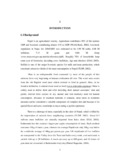Please use this identifier to cite or link to this item:
https://elibrary.tucl.edu.np/handle/123456789/3550| Title: | Prevalence of Fascioliasis Present in Buffaloes of Slaughterhouse in Kirtipur Municipality |
| Authors: | Shrestha, Anju |
| Keywords: | Slaughtering;Buffaloes |
| Issue Date: | 2010 |
| Publisher: | Central Department of Zoology |
| Institute Name: | Central Department of Zoology |
| Level: | Masters |
| Abstract: | 200 slaughtered water buffaloes were examined. 100 were observed during the winter; from November 27, 2007 to February 10, 2008 and 100 were observed during the summer; from June 18, 2008 to July 26, 2008. Out of them, 93 (46.50%) were males and 107 (53.50%) were females. 54 (27%) of them were calves, 51 (25.50%) were adults and 95 (47.50%) were olds. Females were found more infected with fascioliasis. 38.05% of the females had fascioliasis as compared to 16.09% of males. The difference in sex-wise prevalence of fascioliasis was found significant (χ 2 0.05, 1d.f. =11.63). Old animals (35.78%) were infected with Fasciola more often than calves (14.81%) and (29.41%) adults. Difference in age-wise prevalence of Fasciola was significant (χ 2 0.05, 2d.f. =7.45). 35 and 22 positive cases of fascioliasis were observed out of 200 slaughtered animals observed, 100 each during winter and summer season. The season-wise prevalence of fascioliasis was found significant (χ 2 0.05, 1d.f. =4.14). Out of 35 positive cases of Fasciola infection observed during winter, 20 (57.14%) buffaloes had only Fasciola hepatica while 11 (31.42%) had only F. gigantica and 4 (11.42%) had both F. hepatica and F. gigantica. Similarly during summer, out of 22 animals that had fascioliasis, F. hepatica was found in 7 (31.81%) of them while F. gigantica was observed in 12 (54.54%) of them and 3 (13.63%) of them had both F. hepatica and F. gigantica. Infection with Fasciola hepatica (59.65%) was found slightly higher than Fasciola gigantica (52.63%). Faecal sample of 55 (27.50%) buffaloes were found positive for fascioliasis, out of 200 slaughtered buffaloes observed. 33 and 22 positive cases of fascioliasis were observed out of 200 slaughtered animals observed, 100 each during winter and summer season. Females were found more infected with fascioliasis. 37.14% of the females had fascioliasis as compared to 16.84% of males. Old animals (33.68%) were infected with Fasciola more often than calves (14.81%) and (29.41%) adults. |
| URI: | http://elibrary.tucl.edu.np/handle/123456789/3550 |
| Appears in Collections: | Zoology |
Files in This Item:
| File | Description | Size | Format | |
|---|---|---|---|---|
| Cover.pdf | 92.47 kB | Adobe PDF |  View/Open | |
| Chapter(1).pdf | 698.37 kB | Adobe PDF |  View/Open |
Items in DSpace are protected by copyright, with all rights reserved, unless otherwise indicated.
